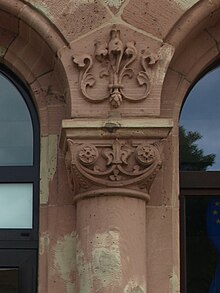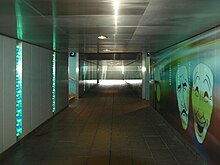Bad Hersfeld train station
| Bad Hersfeld | |
|---|---|

|
|
| Data | |
| Design | Through station |
| Platform tracks | 5 (1–4, 6) |
| abbreviation | FBHF |
| IBNR | 8000020 |
| Price range | 3 |
| opening | 1866/1883 |
| Profile on Bahnhof.de | Bad Hersfeld |
| Architectural data | |
| Architectural style | Neo-romance |
| architect | Paul Rowald |
| location | |
| City / municipality | Bad Hersfeld |
| country | Hesse |
| Country | Germany |
| Coordinates | 50 ° 52 '12 " N , 9 ° 42' 57" E |
| Railway lines | |
|
|
| Railway stations in Hessen | |
The Bad Hersfeld Station is an initiated on its present site in 1883 through station in Bad Hersfeld . It is assigned to station category 3, is an ICE and IC stop and forms a public transport hub in Northern Hesse .
Since 2006 cantus Verkehrsgesellschaft mbH has been serving regional transport on the RB 5 line from Fulda via Bad Hersfeld and Bebra to Kassel .
history
The station was opened with the Bebra – Fulda line in 1866, and between January and October it was the end of the line from Bebra. In 1906 the line to Oberaula and Treysa was put into operation. This route is only in operation for freight traffic to Niederaula; passenger traffic was discontinued on June 2, 1984. In 1912, the Hersfeld circular railway to Heimboldshausen was put into operation, where passenger and freight traffic ended in 1993.
Reception building

For the opening of the Bebra - Bad Hersfeld section on January 22, 1866, only a temporary building was erected as a reception building, the so-called "Bude". The reason was obviously the German war . The temporary arrangement existed for 17 years and was expanded. The wood-shingled building still exists south of the current reception building. This was planned by the architect Paul Rowald , who at the time worked for the structural engineering office of the Frankfurt Railway Directorate and opened in 1883.
The building is a two-story sandstone building in the neo-Romanesque style . It should make a reference to the ruins of the monastery. The floors are separated by a cornice that runs around the entire building. The sandstone for the train station came from a quarry near Jossa. The station building has a rectangular central building, which has a risalit in its long front towards the station forecourt . It ends in a gable which is toned by a cornice. A station clock is built into the gable . In the risalit, the main entrance at ground level, which has the shape of a round arch , is the "typical distinguishing feature" of Romanesque buildings. This shape reappears in all the ground floor windows and the windows in the gables. On both sides of this central building two mirror-like building wings rise up, which protrude slightly in front of the central building both at the front and at the rear. Here the architectural style elements continue from the central building and have high gables.
With the Romanesque style elements, Rowald took up the architecture of existing medieval buildings in the old town of Hersfeld without copying individual elements, for example from the Romanesque monastery ruins (the Gelnhausen train station, also planned by Rowald with the same floor plan, has for this reason similar stylistic forms as the train station in Bad Hersfeld). The neo-Romanesque style should refer to the Romanesque monastery ruins. With the window shapes on the ground floor, the window frame with half-columns and their capitals and the arched tiles on the gables, Rowald took on heavy Romanesque style models. The tops of the gable are adorned with finials , borrowed from the Gothic .
On the south side, a one-story building was added in 1908, which was stylistically aligned with the main building. This building was converted into a pavilion with a hipped roof in 1957. The station restaurant was housed in this building until 2005 .
The exterior of the station has remained largely unchanged, only inside the building has been rebuilt several times and the room layout changed. This last happened between 2005 and 2008. During this time, the station forecourt and the pedestrian underpass were modernized and redesigned. In 2008, the building owners involved, the city of Bad Hersfeld, the North Hessian Transport Association (NVV), Deutsche Bahn AG and the architects involved received the “Simon-Louis-du-Ry-Plakette” award from the Association of German Architects (BDA).
service
The Bad Hersfeld bus station (FBHFU) for regional and local bus routes is located south of the station forecourt . Five intercity lines are operated by RhönEnergie Bus . Six more overland lines are served by the RKH . One line of the total of seven city bus routes guarantees connection to all other city bus routes that depart from Breitenstrasse . There is also a taxi rank and short-term parking spaces in front of the station forecourt . Park & Ride parking spaces exist on the opposite side of the tracks. It is connected to the platforms and the station building by an underpass . Track 1 can be reached at ground level. The underpass, tracks 2 and 3 and the Park & Ride car park were given lifts in 2008 so that barrier-free access is possible. There is a ServicePoint in the station concourse and a DB Service Store since the end of 2008 . The railway offers another service with rental bicycles (since autumn 2009).
To the north of the station building is the building for station management , 3-S control center , signal box and train announcement. The station mission is housed in a flat, wood-shingled building south of the station building.
Long-distance and regional transport
Since December 2017, an ICE has stopped in Bad Hersfeld every two hours in each direction.
| line | course | Tact |
|---|---|---|
| ICE 11 | Munich - Stuttgart - Frankfurt - Bad Hersfeld - Hanover - Hamburg-Altona | individual trains at night |
| ICE 50 | Dresden - Leipzig - Erfurt - Eisenach - Bad Hersfeld - Fulda - Frankfurt (Main) / Frankfurt (Main) Süd - Frankfurt Airport long-distance train station (- Wiesbaden ) | Every 2 hours |
| IC 50 | Bebra - Bad Hersfeld - Hünfeld - Fulda - Hanau - Offenbach (Main) - Frankfurt (Main) | individual trains |
| RE50 | (Bebra - Bad Hersfeld - Hünfeld -) Fulda - Schlüchtern - Gelnhausen - Hanau - Frankfurt (Main) | individual trains |
| RB5 | Kassel Hbf - Kassel-Wilhelmshöhe - Bebra - Bad Hersfeld - Hünfeld - Fulda | Hourly |
| RB7 | Göttingen - Eschwege - Bebra (- Bad Hersfeld - Hünfeld - Fulda) | individual trains |
(As of 2019)
literature
- Thomas Wiegand: District of Hersfeld Rotenburg III . City of Bad Hersfeld. In: State Office for the Preservation of Monuments Hesse (ed.): Monument topography Federal Republic of Germany . Vieweg + Teubner, Braunschweig / Wiesbaden 1999, ISBN 978-3-528-06248-4 , pp. 221-222 .
Web links
- Video animation: Pedestrian underpass based on an artistic idea by Hans Gerhards
- Railway system and some permissible speeds on the OpenRailwayMap
- Tracks in service facilities (FBHF) , DB Netz AG (PDF; track plan)
Individual evidence
- ↑ Grossart: The development of the railway buildings in the Rhine-Main area . In: Die Reichsbahn 16 (1940), pp. 200-215 (204).
- ↑ Bad Hersfeld train station receives the "Simon-Louis-du-Ry-Plakette" architecture prize
- ↑ Call a Bike starts in Bad Hersfeld (accessed on January 23, 2010)
- ↑ Changes in long-distance transport in Hesse in 2018 - Frankfurt international rail hub. In: deutschebahn.com. Deutsche Bahn, October 16, 2017, accessed on October 17, 2017 .


